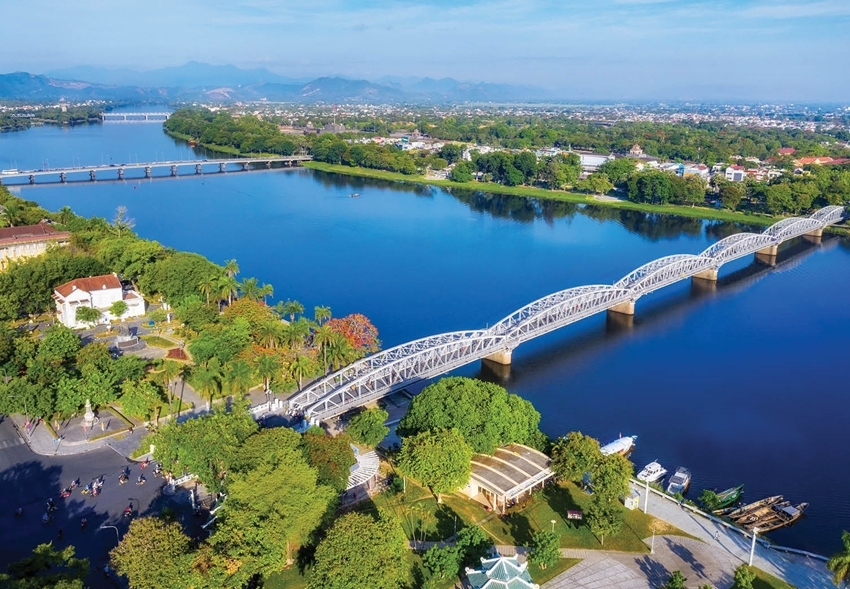To understand how that “hollow and open” space is created, and what benefits it brings to people and the city itself, we had a talk with Nguyen Thanh Tung, an architect and the founder of ANTT Architects.
    |
 |
| Architect Nguyen Thanh Tung |
Hello Mr. Nguyen Thanh Tung. In the recent seminar “Hollowness and Open Space of the City,” you said that Hue is like a large garden house, and that Hue is open and very “porous.” That’s a very interesting concept. Can you explain it in more detail? What factors create this difference?
If we regard the house in a garden or the constructions in a city as the “filled part,” then the “hollow part” of the city is the one without constructions.
That is the empty space inside each house and between constructions. It can be the river network, streets, the system of transport, parks, squares, public commons, gardens in houses, and so on. They together form the “hollow” part of the cities including Hue.
Besides, in Hue, there is another interesting open space. It is the garden house, which is the traditional indigenous combination of the house and the garden throughout Vietnam. But when it comes to Hue, it adapts and refines itself to suit the exclusive nature, environment and climate in Hue.
Likewise, New York City has an open space right in the city center among skyscrapers; it is the Central Park.
In Hue, we have the Perfume River running through the city as a “hollow and open” axis. In addition, we have an overlapped system of urban rivers and streets with the landscape around them.
At the same time, we have a system of houses and gardens, constructions and gardens, phu (princes’ or princesses’ residence) and gardens, pagodas and gardens, royal mausoleums and gardens, etc., especially those in the Citadel and the Imperial City. They together exclusively form a typical “hollow and porous” part for Hue.
To put it in a narrower manner, the hollowness and openness in architecture of the house in the city also needs to be considered so that the people living in it can be exposed to nature and hence receive good energy from nature. In your opinion, how should the “hollow part” in each house be created and stressed?
There are two basic tendencies. They are bringing nature to the house and returning to constructing small houses in a large garden like colonial villas or traditional garden houses, or maybe a combination of those two tendencies.
The Pooh Gardening House which we recently built at 8 Nguyen Tuan Street is a typical case of the combination of those two tendencies. First and foremost, we aim/s at reducing the number of constructions to make room for the garden while meeting all the needs of the owner’s family.
Besides, we also consider the owner’s desire of bringing nature into the house, creating an open space. The house and the garden must satisfy requirements about feng-shui, ensuring the physical and spiritual health for each member in the family.
With the aim of saving 90% of the surface area for trees and plants, we must design in a way that allows growing trees and plants not only on the ground but also on the house roof, forming a three-tiered garden.
The Pooh Gardening House becomes “a garden in the city,” a place full of nature within the city of Hue. It is the perfect place for children to discover and experience their love for nature and grow new shoots.
At the seminar “Hollowness and Open Space” architect Hoang Manh stressed that nature is the most important element of a city and a house. But in reality, nature _ the “hollow part” is being reduced now. What do you think about it?
While places such as Saigon, Hanoi or New York City lack open space, Hue is “porous” with lots of open space and full of nature. Big cities with high urbanization mean high demand in construction and their open space thus keeps shrinking.
    |
 |
| The Perfume River running through the city of Hue. Photo: Minh Hoa |
Urban planners, policy makers, or urban managers play a very important role. What architects can do takes place within their houses and constructions they build. They can persuade their clients to decrease construction and increase open space for nature, which, in turn, increases their quality of life.
Architects understand that the open space in each construction contributes to the open space of the city as a whole. That is the “architecture that heals,” as expressed by architect Nguyen Hoang Manh.
Hue has been so far preserving its typical valuable open space. In your opinion, what should we do so that the open space in Hue is not only maintained but also expanded?
“I think Hue really needs long-term planning aiming to protect the open green space in the relic complex and the city including public places such as squares, tree-bordered streets in both the old quarters and the new ones.
The most important thing is to preserve the Perfume River with its tributaries and the landscape along it, both in and out of the Citadel. We should have plans to conserve and develop the Perfume River axis sustainably in relation to history, culture, society, science, economy and environment. In order to do so, we need the love for houses and gardens in Hue.
Thank you, sir.